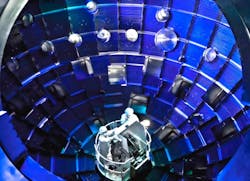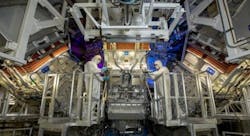AI and Laser Fusion: AWS Integrating Generative Models into Livermore Lab's National Ignition Facility
One of the world’s largest and precise energy laser systems, making headlines only a few years ago to create an historic nuclear fusion ignition, will now expand its operational reach with new artificial intelligence (AI) tools from Amazon Web Services (AWS).
The Lawrence Livermore National Laboratory announced today it is partnering with AWS on developing an AI-driven troubleshooting and reliability system for the National Ignition Facility (NIF) in Livermore, California. Livermore National Lab already uses AI tools to manage data, such as predictive modelling and design optimization.
What will be unique about the AWS AI system is the integration of generative AI capabilities on operations at the federally run ignition facility. The NIF is where Livermore engineers announced a milestone of nuclear fusion ignition in December 2022, delivering 1.3 megajoules of energy from a fusion attempt. The lab has repeated and expanded on its short-term fusion success seven more times since then.
The Livermore NIF stands out among laser facilities worldwide. It can deliver “more than 2 million joules of ultraviolet energy and 500 trillion watts of peak power to a target the size of a pencil eraser,” according to the website.
“I’m excited to unleash the superpower that is AI on NIF operations,” said Kim Budil, director of the Livermore National Lab, in a statement about the partnership with Amazon Web Services. “By leveraging our extensive historical data through advanced AI techniques, we’re solving today’s problems faster and paving the way for predictive maintenance and even more efficient operations in the future.”
The AI integration project with AWS seeks to address real-time resolution of anomalies in operations, while also easing the growing array of operational challenges.
“NIF is an incredibly complex facility that operates with extreme precision. We run 24/7, executing approximately 350 high-energy-density physics experiments each year,” said NIF Operations Manager Bruno Van Wonterghem. “This intelligent system analyzes 22 years of operational history across hundreds of NIF’s subsystems to help our staff resolve issues more quickly and keep experiments on track.”
AWS is working its generative AI solution into the project by providing intelligent search, summarized large-language-model response and retrieval-augmented generation chatbot functionality. The tools include Amazon SageMaker, the AI-enabled and cloud-based machine-learning platform first launched in November 2017.
It is hoped by many nuclear energy enthusiasts that AI can open a gateway into nuclear fusion, which is the reaction that powers the sun and so far has proved impossible to control and commercialize. AWS is involved in nuclear fusion research through support of several companies doing that work, including awards of AWS cloud-computing credits to startup Thea Energy and others as part of a collaborative effort with UNESCO’s International Research Centre on Artificial Intelligence.
The commercialization of nuclear fusion, if ever achieved, promises unknown quantities of carbon-free and high-capacity-factor energy for the future of electrification. The U.S. already employs nuclear fission reactors at more than 90 power plants nationwide, generating about half of American carbon-free utility-scale power.
“Livermore is an innovation and scientific powerhouse and we’re extraordinarily proud of our partnership together,” said David Appel, vice president of U.S. Federal Sales at AWS.
AI offers both challenges and solutions in the coming energy future. Providing GWs of power for training model consumption is creating both uncertainty and new work on expanding electricity capacity in coming decades.
At the same time, the technology promises more efficient and predictive operations and maintenance capabilities that could avoid wasted GWs of energy.
About the Author
Rod Walton, EnergyTech Managing Editor
Managing Editor
For EnergyTech editorial inquiries, please contact Managing Editor Rod Walton at [email protected].
Rod Walton has spent 17 years covering the energy industry as a newspaper and trade journalist. He formerly was energy writer and business editor at the Tulsa World. Later, he spent six years covering the electricity power sector for Pennwell and Clarion Events. He joined Endeavor and EnergyTech in November 2021.
Walton earned his Bachelors degree in journalism from the University of Oklahoma. His career stops include the Moore American, Bartlesville Examiner-Enterprise, Wagoner Tribune and Tulsa World.
EnergyTech is focused on the mission critical and large-scale energy users and their sustainability and resiliency goals. These include the commercial and industrial sectors, as well as the military, universities, data centers and microgrids. The C&I sectors together account for close to 30 percent of greenhouse gas emissions in the U.S.
He was named Managing Editor for Microgrid Knowledge and EnergyTech starting July 1, 2023
Many large-scale energy users such as Fortune 500 companies, and mission-critical users such as military bases, universities, healthcare facilities, public safety and data centers, shifting their energy priorities to reach net-zero carbon goals within the coming decades. These include plans for renewable energy power purchase agreements, but also on-site resiliency projects such as microgrids, combined heat and power, rooftop solar, energy storage, digitalization and building efficiency upgrades.


